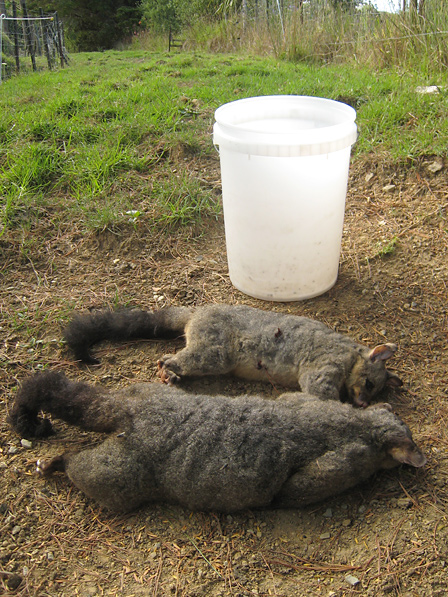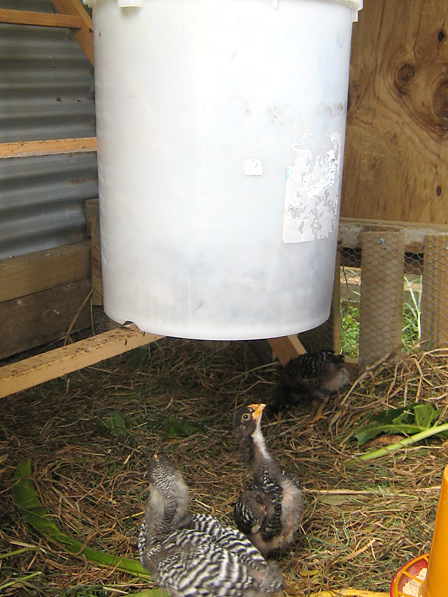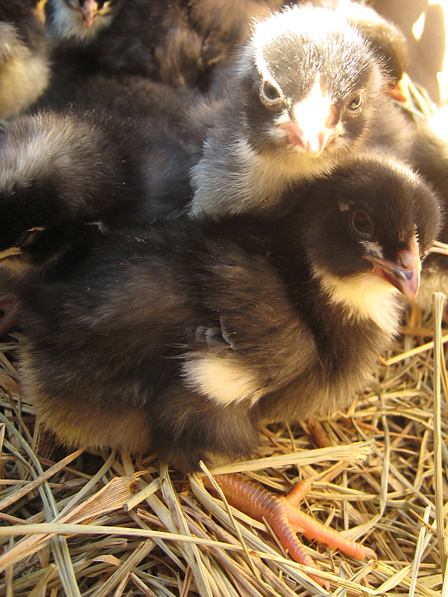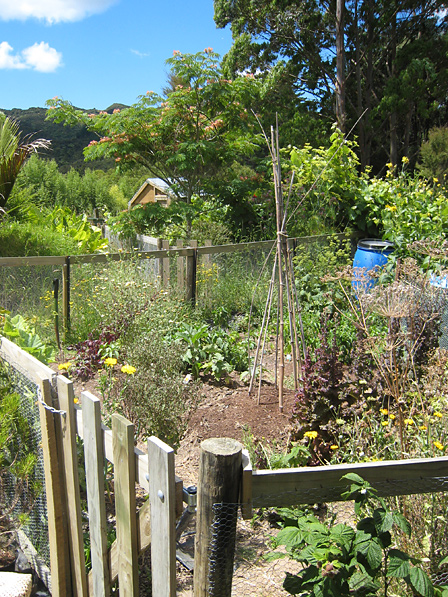We’re going to start posting some videos on YouTube. Check us out if you like: farmlet.tv
Archive for the ‘Wildlife’ Category
farmlet.tv
Thursday, May 5th, 2016Maggots as Food for Chickens
Monday, February 8th, 2010WARNING: This post contains images that may not be suitable for some readers.
Our chickens have been living in their new poultry house for a few days now and they’re doing great. I was keen to get started on the feeding program that involves possum (Trichosurus Vulpecula) carcasses and maggots.
I’d heard enough about theories and vague references to stuff of legend. It sounded good, but I’d have to try it for myself.
There’s not much to it: Put some fly blown carcass in a bucket with holes at the bottom and hang it over the ground in the presence of chickens.
With that, I stepped outside one night and shot a couple of possums. I let them lie where they fell until the next evening when I went to collect them. We’re past the middle of summer here, so fly activity was well underway. There were small, standard “house-fly” flies and also a type of fly I’ve never seen before; a massive fly with a beautiful dark blue sheen that was probably some variety of flesh-fly.

Note to self: One possum per 20 litre bucket would be plenty

Bucket of dead possum, no less than ten pounds worth, more like twelve
I initially thought about drilling 10mm holes in the bottom of the 20 litre bucket, but I decided to make them much larger. It seemed like 10mm moles were going to get plugged up with clumps of fur and possibly some meatier bits. The holes in the bottom of the bucket below are 30mm across. I don’t know if there’s a right way or a wrong way to do this, but here’s what I did:

30mm holes in the bottom of the bucket

Waiting… Waiting…
I hung the bucket up in the chook house, but nothing much was happening just yet. The action really started on the third day after the possums had been killed. Small maggots were raining out of the bucket and the chickens were engaged in a pretty much non stop feeding frenzy. They REALLY like the maggots. Some of them were leaping up, trying to snatch the morsels before they could even fall out. The instant a maggot touches the ground, it gets snapped up. This went on all day, and the last time I checked around nightfall, a couple of chickens were still at it.
In case you’re wondering: What’s the smell like?
It’s incredibly mild so far. I was expecting a fairly fierce odour today (three days postmortem, middle of summer/hot/high humidity). But on a scale of one to ten, one being barely noticeable and ten being stifling rotting carcass odor, I’d rate the smell at one inside the chook house,
but undetectable just outside it. I’ll update as the days (and the breakdown) go on.
We’ll also be watching to see what happens to the consumption of their commercial feed. With any luck, it should be decreasing.
My initial assessment is an enthusiastic thumbs up.
Update #1: Smell Increasing, Maggot Output Decreasing
Ok, there is a wrong way, and that’s what you’ve just read above.
I went out today and there was plenty of smell and not many maggots. Remember my rating scale for smell intensity? It was about a six inside the chook house and four to five outside the chook house.
I definitely didn’t want to change the plan with four-days-dead possum carcasses, but it had to be done. The problem was that the mass of possum was clogging up the base. There were lots of maggots in the bucket, they just couldn’t escape. Additionally, it had been going with the lid on, so I think we were starting to get an ugly anaerobic situation.
From reading the Humanure Handbook, I remembered the advice about “biofilter” for dealing with strong smells. Biofilter simply means any dry organic matter that you happen to have handy. If you have something that really reeks, throw some biofilter on top and you’ll cut down the smell, or eliminate it entirely. It’s incredible how well this works with composting toilets (I know because I’ve tried it). I decided to get some biofilter into the mix with my dead possum bucket. For biofilter, I’m using mostly dry kikuyu mixed with some other random dry weeds and plant matter.
I rearranged my bucket like a layer cake:
Top layer: Biofilter, with a couple handfuls of sawdust sprinkled on top, no lid this time
Middle layer: Possum mass
Bottom layer: Biofilter
That’s better.
Now, the holes at the bottom aren’t clogged with guts and fur and the rest of it. I hung the bucket back up and very slowly, maggots started dropping out again.
The smell started decreasing almost immediately, but I’ll wait until tomorrow for everything to settle before I give it a rating.
It was definitely a mistake to use two possums at once. One per bucket from now on.
—End Update—
Update #2: Added More Biofilter
Just a little update. The biofilter vastly improved the situation with the smell. I decided to add about three inches of sawdust over the top, which helped even more. I’d rate the intensity of the smell at one to two inside the chook house and zero to one outside.
Other sites:
Finally, We Have Chickens
Thursday, January 28th, 2010We recently bought eighteen two-day-old Barred Rock chicks. They were unsexed, so we will probably wind up with something like half of them turning out to be roosters.
Chickens, used properly, are outstanding creatures for permaculture systems. In addition to devastating the dreaded and fast moving kikuyu grass and other weeds that we have here, the chickens will provide us with manure for fertilizer, eggs and meat. They’re also a source of constant entertainment for young Owen and someone like me who has never kept chickens before.

Barred Rock chicks, two days old
We knew we wanted a dual use breed (good for both eggs and meat). I thought that the Australorp was a good choice. However, we couldn’t find any for sale in the area. We decided to go with what had a good reputation locally, what was available locally and what was immediately available.
We found a local couple who breeds Barred Rock chickens, (and several other varieties or chickens and ducks). I doubt that you’ll find anyone who knows more about chooks than Ken Vincent! He has been breeding and showing his chickens in competitions around the world for decades.
If you’re in the Far North of New Zealand and are looking to get some chickens and or ducks for yourself, contact Ken and Ruth Vincent in Kaitaia. Phone: (09) 408 3929.
So, Becky rang the Vincents and they had the Barred Rock chicks available. We did a bit of research and decided that they seemed like an outstanding choice. They’re very popular in New Zealand and in the U.S. (it’s a U.S. breed)—and probably lots of other places. Barred Rock are good layers, good meat birds, have a generally quiet temperament and rarely go broody.
We knew that making chickens work for us would require a plan and a system. After expending a great deal of money, time and effort (Becky’s dad, my father in law, did most of the building—both of my brothers’ in law helped with the chicken house), we have totally converted our gardens into what I would call an integrated rotational chicken system. The garden is now broken up into individual pens of between fifteen and twenty square metres. All of the pens are connected via a central race. Access to each pen is controlled. The chooks are only able to enter the pen or pens we want them to enter.
Our fences are only a metre high, but we think that will be high enough to contain the chickens for two reasons: First, Barred Rock is a large bird. Second, we’re going to clip their flight feathers. If they do manage to escape, we have a couple of options to remedy the situation. We’ll cross that bridge if we come to it.
As for the layout, our gardens describe an L-shape in our Zone 1 and the main chicken house is located at the angle where the two legs of the L come together. This location is also the gateway area to Zone 2. We are able to send the chickens into Zone 2 as necessary. (See Wikipedia for an overview of permaculture zones, if you’re not familiar with the concept.)

Garden with partitions. The chicken house is visible centre left of frame.
The plan is to move the chickens from pen to pen as required. The chickens will provide tillage (weeding) and manure as they go.
What will we do with all the roosters?
Becky and I like to eat chicken. I really like to eat chicken. Industrial poultry production, however, has put both of us off of it. While it is possible to obtain organic chicken here, I’m not quite sure who is able to afford it. Definitely not us. So, we’re going to go about getting chicken meat in a more traditional manner…
As for what we’re planning on feeding the birds, it’s going to be a variety, most of which they will be finding themselves. We will grow some amaranth for them and possibly other grains that do well here. A major source of protein for them will be maggots. We have an inexhaustible supply of possums here. I have been resiting the urge to grab my rifle and head out into the night lately. I’m letting them build up until our chickens are outside full time. At that point, I will begin trapping and shooting possums at will.
After ripening for about a day (fly strike), the possum carcass will be placed in a 20 litre bucket with 10mm holes drilled around the base. The bucket is suspended above the chickens. People who have done this report that the chickens simply camp out below the bucket, waiting for the next pennies from Heaven to fall. Use biofilter (straw, sawdust or other matter) to keep the smell down.

Farmlet chickens will feast on maggots derived from possum carcasses
While it’s a simple matter to buy bags of feed for chickens, that practice is both expensive and likely to be disrupted in the future (energy shortages, economic collapse, weather related calamity, take your pick). Our goal is to see how little feed we need to buy. Ironically, the possum, a threat to multiple species and habitats in New Zealand, readily converts into maggots that the chickens love to eat.
This is just a general overview. We don’t really know the particulars of how this is going to work, or not work. The permaculture materials I’ve looked at are notably useless when it comes to details on systems like this. (Mollison’s Designers’ Manual has a couple of pictures of one operating in Hawaii.) So, we started with the theory and tried to come up with a plan to make it work.
Happy New Year from the Garden
Tuesday, January 13th, 2009Happy New Year to you all! The garden is wonderful at this time of the year — full of lush green leaves and bright flowers. We are still enjoying fresh salad greens. Amazingly, some of our lettuces and arugula still haven’t bolted yet. We are also feasting on plenty of summer squash (“black beauty” zucchini and tromboncino) and green beans. The potatoes are flowering, and tomatoes, peppers and grape are setting fruit. It feels like a happy New Year, for sure!
Owen loves to be outside in the garden, and already knows what to do with a spade. He’s so busy and keen to help and explore. I’m finding that I have to send him and Kevin off on little adventures if I’m to get much work done.
Some volunteer swan plants have come up in our garden. As luck would have it, one is right outside the kitchen window. Several monarch butterflies have been visiting, and we are seeing the first little caterpillars hatching out. When Owen is a bit older, it will be fun to make a proper butterfly garden together.






The Year of the Pig in Review
Monday, March 3rd, 2008Best wishes to all for the Year of the Rat!
One year ago, at the beginning of the Year of the Pig, I set out a list of 13 goals for the Farmlet. With the year now over, it is time to review our goals and achievements, and to set new goals for the coming year.
Here’s the report on last year’s goals:
1. Have some earthworks done in the middle cow paddock, in order to create an irrigation dam and level a site for a barn. The cows will be fenced out of the dam area. (The area in question is already swampy and damp — not especially good grazing, but an excellent dam site. The elevation of the site will allow us to gravity-feed water to gardens and stock. We plan eventually to plant the area around the dam with trees, creating a special dam-microclimate.)
Yes, we had the earthworks done. Sites have been leveled for a shed and a large water tank. The dam filled up beautifully and has stayed full of water right through the summer. We have surrounded the dam area with electric tape and planted mustard and lupins in the turned soil to prevent erosion. Still to do: Establish the gravity feed water system and plant trees around the dam area.
2. Build a barn/shed in the cow paddock for milking, storage, and keeping calves. We need to have this in place by July, when the cows are due to calve. (In due course, we plan to collect rain water off the roof of the barn. We will install a water tank next to the barn, from which water can be gravity-fed down to to house.)
The barn/shed project was shelved. We have been grazing our animals down on our neighbour’s pasture, in the middle of which is an old milking shed. Having the use of this shed took the urgency out of our need to build our own. We still plan to build the shed eventually, but other projects now seem more pressing.
3. Fix the fences around the goat paddocks. We need to reinforce the fences and put in more electric wires, so that the goats can be kept in the paddocks without their A-frame collars on.
Kevin fixed the goat paddock fences, with the result that they are much more goat proof. What a relief!
4. Extend the goat houses to give the goats more space, and better access to dry feed during the winter.
We have not done this yet. Now, with the goats expected to kid this coming spring, this project needs to move to the top of the priority list!
5. Build a chook house, and get some chickens. We plan to start with a small movable chook house in the house paddock. This way, the chooks can help us to clear kikuyu and create new garden areas. (Eventually, we would like to have a larger number of chickens ranging on the pasture up the hill.)
Alas, we still have no chooks! Over the past few months, Kevin and I have started to change and refine our chook house/ chook run plans. We are determined to tackle this project soon.
6. Plant fruit trees. Build supports for passion fruit and kiwifruit vines.
We have planted some more fruit around the place — a guava, a naranjilla, a boysenberry, a couple of tropical apricots and a grapefruit. I have also propagated seedlings for more passionfruit (both purple and yellow varieties), cherimoya, plum and guava, and we have been given a small fig, a raspberry, a thornless blackberry, a blackcurrant and a macadamia nut. We have to find places to plant all these! The passionfruit have supports to climb on, and we have just been enjoying the first fruit. The kiwifruit still need a pergola to climb on. They are looking a bit wretched after getting a rather fierce pruning from Daphne — naughty goat.
7. Continue to expand and develop gardens in the house paddock – including barrier plantings to keep out kikuyu.
We expanded the gardens by a considerable margin this spring, clearing the area that we are now using to grow corn and beans. We also worked on improving the soil structure in the existing beds. I didn’t do much work on barrier plantings in the end.
8. Experiment with making kefir, quark, and various cheeses. (This will be happening after our cows have calved and we have a good supply of fresh milk. We also hope to continue making yoghurt and butter.)
We have enjoyed making kefir, kefir cheese, Caspian Sea yoghurt, and butter using milk and cream from our own cow, Coco. I have to admit, though, that since Owen came along, I’ve really only kept going with the yoghurt (we get through several litres of this every week), having killed off our poor kefir grains soon after he was born. I’ll have to get some more! We’ve also been buying butter, which saves time, even if it’s not as nice as making our own. I’ve had several attempts at quark, and all have turned into yoghurt. The yoghurt culture has obviously taken up firm residence in this house and seems set on colonising any milk that I leave out at room temperature! Not good news for my quark mission.
9. Experiment with making assorted fermented beverages — perhaps using herbs from the garden.
I have had a lot of fun with fermentation over the past year, including growing a ginger beer bug and making ginger beer using our own lemons. I’ve also made water kefir using lemons and herbs from the garden. Sadly, the water kefir grains got very sulky quite some time ago, and nothing I could do would revive them. I am now looking to purchase some more. We continue to brew kombucha.
10. Grinding flour and making sourdough bread has become part of our routine by now. I’d like to get into the habit of using the sourdough in some other creative and delicious ways.
Yes, during the past year I found some delicious sourdough recipes in “Full Moon Feast” — sourdough pancakes, crackers and scones. I have also used sourdough to make fishcakes and pizza crust. By now, these recipes have become old favourites.
11. Start growing some “bushman’s toilet paper.†We plan to start seedlings and plant them out in the garden when they are big enough.
Ah. . . ! I’d forgotten all about this one. But it sounds like a neat idea. We should do this!
12. Install a solar hot water heater to cut our power bill and increase our energy self-sufficiency.
Kevin has been researching our options in this area, and has finally found one that looks right for us. With any luck, we’ll soon be embarking on this project.
13. Keep a more systematic record of income and expenditure. In particular, I think it will be satisfying to have records that clearly document the changes in our grocery bills as we produce more and more of our own food.
I kept these records very diligently through until October last year. Since our little one was born, my attentions have been focussed elsewhere, to the detriment of my record keeping! I hope the records will remain a useful basis for comparison as the Farmlet changes and develops.
So. . . does that mean we’ve achieved 8 out of our 13 goals? I suppose that’s not too bad.
The Year of the Pig has been a special one for us. Our goats grew to maturity, the first Farmlet calves were born, Kevin learned to milk a cow and shot his first wild pig. I got my firearms license. We had a rough time when Coco’s calf was born dead and we had to mother a new calf onto her. . . and it was hard to say goodbye to our fabulous cow, Esmerelda, even though she was going off to an excellent home. Of course, by far the most significant event of the year for us was the birth of our precious baby: Owen Thom Flaherty, born on the 16th of November 2007, Year of the Red Fire Pig. Our very own dear little piglet.

Owen
Now I’ve started compiling a new list of goals for the Year of the Rat. I hope to post this list in the next few days, so please stay tuned.